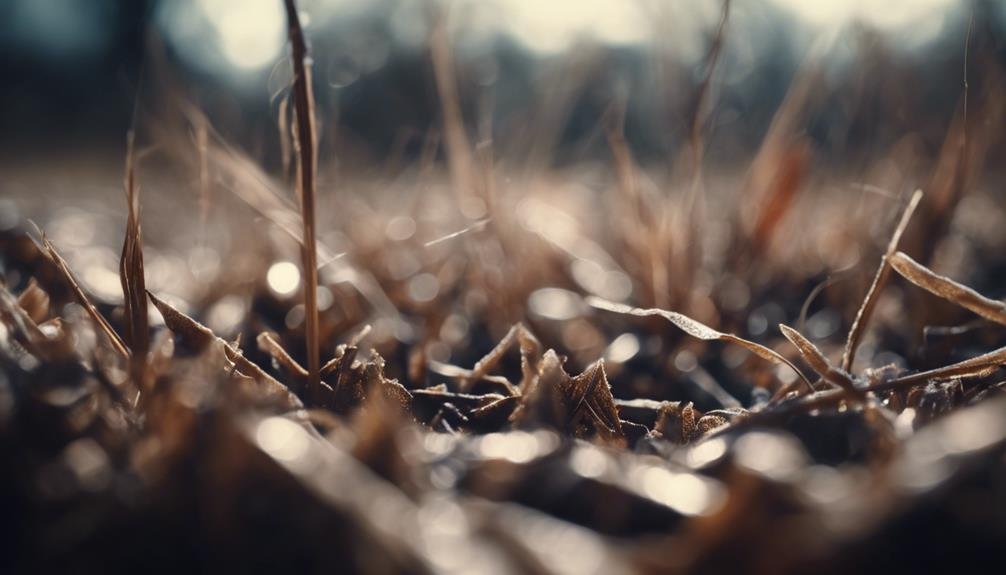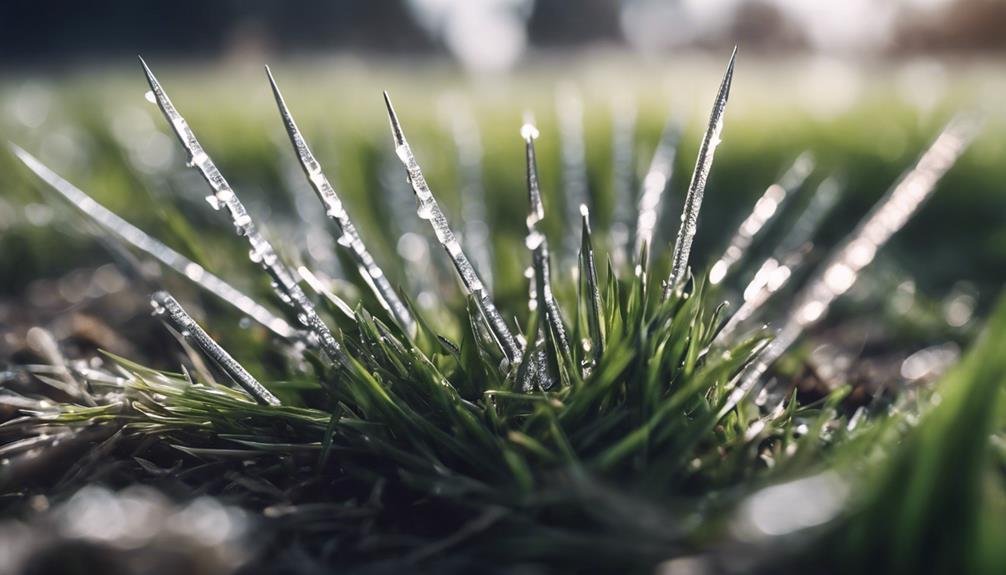Winter calls for specific aeration techniques to maintain the health of your lawn and garden. Core aeration is a great option as it removes soil plugs, allowing air and water to reach deeper into the ground.
Liquid aerators are also beneficial as they introduce helpful microbes through soil channels. Power raking is essential for eliminating thatch buildup and improving air circulation.
Using slicing equipment can cut through frozen soil, creating grids that aid in better air flow. Spiking, on the other hand, helps aerate the soil surface without compacting it too much.
For compost piles, consider inserting perforated pipes or using blowers to ensure proper oxygen levels. Mulching is another effective way to promote air exchange around plant roots.
These techniques are vital for winter lawn and garden care, helping to keep your outdoor space healthy and thriving during the colder months.
Manual Core Aeration
Manual core aeration is a process where a tool with hollow tines is used to remove small plugs from the soil, improving air and water movement in the lawn. By pushing the aerator into the ground, soil cores are extracted, creating holes that enhance air circulation. This activity helps alleviate soil compaction, allowing roots to grow deeper and access water, air, and nutrients more easily. The removed soil cores break down over time, enriching the soil structure.
It is best to perform manual core aeration in the fall or early spring when the grass is actively growing. However, it can also be done during winter dormancy if the ground isn't frozen solid. It's important to avoid aerating when the soil is excessively wet or dry as this could harm the lawn.
This process is beneficial for maintaining a healthy lawn by promoting root growth and improving soil quality.
Liquid Aeration Methods
Liquid aeration is a practical option when mechanical core aeration isn't feasible due to frozen or excessively wet ground during the winter months. There are two primary liquid aeration methods: liquid aerators and aeration fertilizers. Liquid aerators contain beneficial organisms that move through the soil, creating channels as they go. These microbes break down organic matter, making way for air and water to flow more easily.
On the other hand, aeration fertilizers contain ammonium compounds that interact with the soil, forming gas pockets that gently expand and help break up the soil for improved aeration.
Both liquid aeration methods are particularly effective in winter when the ground is less penetrable. They've an advantage over solid aerator tines as they can better seep into the soil surface.
However, it's essential to note that liquid aerators and aeration fertilizers may not offer the same depth or long-lasting aeration benefits as mechanical core aeration performed under optimal soil conditions. These liquid methods are best used as supplementary approaches to combat compaction during the winter months until core aeration can be performed in the spring.
When applied correctly and timed appropriately, liquid aeration can be a valuable addition to our lawn care routine.
Power Raking Approach

Power raking is a practical method for aerating lawns during the winter season when traditional core aeration isn't feasible. This technique involves using a gas-powered machine with sturdy tines or blades to rake through the top layer of soil and thatch. By creating grooves, it enhances air and water penetration while eliminating excess dead organic matter and loosening compacted soil. This process facilitates improved air circulation at the soil level, which in turn fosters healthier grass roots throughout the winter months.
It is advisable to perform power raking in late fall or early winter, preferably when the grass is dormant but before the ground freezes completely. This timing ensures that the lawn is well-prepared for the harsh winter conditions without causing harm to actively growing grass. The areas that undergo power raking develop robust root systems, enabling them to withstand the cold temperatures more effectively.
Although not as deep as core aeration, power raking serves as a convenient substitute when soil conditions aren't conducive to core removal. It revitalizes lawns by enhancing the efficiency of oxygen, water, and nutrient delivery to the grass roots during the challenging winter period.
Slicing Soil Strategy
One effective method we use involves cutting through the permafrost layer to aerate the frozen topsoil below. This process utilizes specialized equipment to break through the tough upper crust, allowing oxygen to reach the soil.
Cutting Permafrost Layer
When dealing with frozen permafrost, we'll utilize a slicing soil method with specialized equipment to create pathways for air circulation. This technique involves heavy-duty machines with powerful blades or ripper teeth to break through the frozen ground. By cutting deep trenches, we allow air to reach the soil, aiding plant roots and soil microorganisms.
Careful planning is essential, considering soil composition, moisture levels, and permafrost depth. A grid-like pattern of evenly spaced trenches will be created, adjusting the width and depth based on site conditions.
Additional aeration methods like core aeration may be used after slicing to improve air flow.
Safety measures and environmental concerns are paramount throughout to ensure the effectiveness and sustainability of this winter aeration approach.
Aerating Frozen Topsoil
When dealing with frozen topsoil, it's crucial to aerate the soil to ensure proper oxygen circulation for healthy root growth in the upcoming season. One effective method is core aeration, where small plugs of soil are removed to create pathways for air, water, and nutrients. This technique promotes better soil penetration and overall soil health.
Another approach is spiking, which involves driving solid tines into the ground to create channels without disrupting the soil structure too much. This method is ideal for areas with delicate grass or groundcover that need a gentler touch.
Additionally, slicing the soil with a sharp blade can improve air exchange and drainage by creating clean slits that allow for better oxygen flow.
Each of these techniques plays a vital role in oxygenating frozen topsoil and preparing it for a successful growing season. By choosing the right method based on the soil condition and landscaping requirements, you can ensure that your soil is primed for optimal plant growth.
Spiking Lawn Technique

Spiking is a straightforward method to aerate a lawn, enhancing soil quality by allowing air and moisture to reach the roots of the grass. The spiking lawn technique involves using a specialized aerator with solid, spike-like tines to create holes in the soil, reducing compaction and improving drainage for healthier grass growth.
Before spiking your lawn, ensure that the soil isn't frozen or overly wet. Choose a time when the soil is just right for the spikes to penetrate effectively. When ready, make multiple passes over the lawn, overlapping each row to ensure thorough aeration. Avoid spiking when the ground is too wet, as it may lead to further compaction issues.
After spiking, clear any debris and lightly top-dress with compost or soil to fill the holes created.
Unlike core aeration, spiking doesn't remove soil cores, making it a less disruptive option, especially during winter months. It's a simple yet effective way to improve the overall health of your lawn by enhancing soil quality and promoting better grass growth.
Consider incorporating the spiking lawn technique into your lawn care routine to keep your grass lush and vibrant throughout the year.
Aerating Compost Application
Let's explore various methods to aerate compost piles effectively to ensure proper oxygen circulation. Adjustments to temperature may be necessary depending on seasonal variations.
We'll guide you on the frequency of turning the compost to maximize aeration. These techniques are essential for creating an optimal environment for efficient composting, especially during the winter months.
Compost Aeration Methods
During the winter months, it's crucial to aerate and mix our compost pile to ensure proper oxygen flow and microbial activity. Here are three effective methods we can use:
- Turning:
This method involves physically mixing the compost pile using a pitchfork or aerator tool. By turning the pile, we introduce oxygen, prevent compaction, and redistribute materials to maintain aerobic conditions.
- Aeration Pipes:
By inserting perforated pipes or tubes vertically into the compost pile, we allow air to flow through and ensure oxygen penetrates the interior of the pile, promoting microbial activity.
- Forced Aeration:
Utilizing a blower or fan to pump air into the compost pile is an efficient mechanical aeration method. This approach is especially beneficial for larger-scale operations or when the pile is densely compacted.
Regular aeration is essential to prevent anaerobic conditions, which can lead to odor problems and slow decomposition. By oxygenating the compost, we support the growth of beneficial aerobic bacteria that break down organic matter efficiently. Consistently aerating the compost throughout winter will keep it active and healthy, even in colder temperatures.
Seasonal Temperature Adjustments
To optimize composting in winter, when lower temperatures slow microbial activity, it's crucial to adjust aeration practices.
Rather than frequent turning, reduce aeration to prevent anaerobic conditions while still allowing some airflow.
One effective technique is using aeration pipes or stakes to maintain circulation without overly disturbing the outer layers.
Covering the pile with a tarp or insulating material helps retain heat and avoid excessive cooling.
Avoid excessive disturbance to preserve the pile's heat, ensuring a conducive environment for decomposition while conserving energy.
Turning Frequency Guidelines
During the winter months, it's recommended to turn compost piles less frequently to account for the lower temperatures. However, it's still crucial to turn them often enough to prevent anaerobic conditions.
The general guidelines for turning frequency are as follows:
- If the composting process is active, aim to turn the pile every 4-6 weeks.
- In case decomposition has slowed significantly due to the cold weather, consider turning the pile around every 2-3 months.
- Keep an eye on the temperature and moisture levels of the pile, adjusting the turning frequency as necessary to maintain optimal conditions.
Turning the compost pile too frequently in winter can expose it to excessive cold air, which can slow down the decomposition process. On the other hand, insufficient aeration can lead to anaerobic conditions, resulting in unpleasant smells and sluggish decomposition.
Striking a balance is key—turn the pile just enough to introduce oxygen and maintain aerobic conditions without causing it to cool down excessively. It's essential to monitor the pile closely and adapt the turning frequency based on its specific needs and the severity of the winter weather.
Mulching for Oxygenation

Adding a layer of mulch in winter helps oxygenate the soil below, promoting air circulation while providing insulation against extreme temperatures. Opt for a well-draining organic mulch like shredded leaves, straw, or wood chips, spreading it 2-4 inches thick once the ground freezes. This mulch acts as a barrier, keeping the soil from freezing and thawing erratically, which can disrupt plant roots.
As the mulch breaks down over the winter, it creates air pockets within the soil, allowing oxygen to reach deeper layers. This process helps prevent soil compaction and enhances drainage when spring arrives. Adequate oxygen is crucial for root respiration and the activity of beneficial soil microbes that decompose organic matter.
Reapplying mulch if it becomes compacted or scattered by winter storms ensures continued soil oxygenation until it's time to cultivate the soil again in spring.
Conclusion
We've seen how aerating our lawn can help keep our turf healthy during the winter months. Our neighbors tried an unconventional method last year by using spiked sandals to aerate their lawn, and it surprisingly worked well.
Whether we opt for spiked sandals or another aeration technique, the key is to aerate consistently to ensure optimal oxygen flow, which will strengthen the roots and result in a lush, vibrant lawn when spring arrives.

